Mt. Hymettus Orchids
Welcome to Athens and our Orchids Album! The vast majority of the inquisitive visitors to Athens are usually facing a big dilemma: Spend some time here before their island hopping to the Aegean or abandon everything and rush to their dream destination as soon as possible? Trying to make a decision one is tempted, mainly or exclusively, by the Acropolis, dominating the city skyline, and the New Acropolis museum. Few are aware that in the same city, less than two miles away, there is one of the top museums worldwide, namely the National Archaeological Museum, full to the brim with masterpieces of prehistoric and historic art of utmost importance: the Mycenaean gold jewels and artifacts are just a few of these treasures. As if these were not enough, this album comes to make things worse. Because, once on the Acropolis rock, or even in the Acropolis Museum, your view to the east is blocked by Mt. Hymettus, a mountain offering one of the richest habitats as regards its flora. To the plant enthusiast Greece in general, Attica in particular, are "dreams come true" and exploring them, camera in hand, is an absolute must. The photos in this album (and the ones to appear in this site in the near future) are meant to be just an appetizer, hoping to make Mt. Hymettus appealing to the "beauty enthusiast" as well. If you wish to take part in a photographic plant safari to Mt. Hymettus, please do contact us. We'll take you around to spots where the chances of finding orchids are best. Late winter to midsummer is when they're more frequent: different species bloom at varying periods. The captions of the photos in this album inform you about the date they were taken.
Select Page of the Album:
Click on any of the pictures to enlarge.
Serapias vomeraceaFull Name: Serapias vomeracea (Burm.f.) Briq. 1910, Prodr. Fl. Corse 1: 378 Common Name: Long Lipped Serapias or the Plow-Share Serapias Taxonomy | Regnum | Plantae | | Divisio | Tracheophyta | | Subdivisio | Spermatophytina | | Class | Magnoliopsida | | Suoerordo | Lilianae | | Ordo | Asparagales | | Familia | Orchidaceae | | Subfamilia | Orchidoideae | | Tribus | Orchidae | | Subtribus | Orchidinae | | Genus | Serapias | | Species | Serapias vomeracea | The following text is based on the relevant Wikipedia article:
Serapias vomeracea is an herbaceous perennial plant with two ovoidal underground tubers. This species is highly variable in color and shape. It reaches an height of 20–40 centimetres (7.9–15.7 in), with a maximum of 60 centimetres (24 in). The stem is green, with two membranous basal leaves and 6-8 upper leaves, lanceolate and glossy green or reddish.
The inflorescence is composed by a narrow and elongated spike, with three to ten flowers. The relevant bracts are lanceolate and much longer than the tepals. Their color is red-purple, with darker longitudinal venation. The outer tepals are lanceolate and erect, forming an helmet-like structure. Their color is purple-red or pinkish, with veins of darker color. The internal lateral tepals are brownish-purple and almost entirely hidden by the helmet.
The labellum is brick red, trilobed and larger than the other tepals. The basal portion (hypochile) of the labellum is concave and enclosed in the helmet, with two raised and hairy lateral lobes. The apical portion of the labellum (epichile) is triangular-lanceolate, usually purple-red and quite hairy. The spur is missing. The flowering period extends from March to June. Reproduction Serapias vomeracea is an entomophilous plant, but cannot offer floral rewards to pollinators, as it does not produce nectar. Therefore this orchid has a deceptive strategy, as pollinators are just attracted by the shape of the flower, forming a small tube used by insects to rest by night or as a refuge against the rain. In this process the pollen stick to the pollinators' bodies. Once they leave their shelter, they will deposit the pollen on other flowers and will fertilize them. These orchids are mainly pollinated by some beetles (Oedemeridae and Lymexylidae family) and by Hymenoptera (genus Ceratina, Eucera and Osmia). The dispersal of seeds is granted by the wind (anemochory).
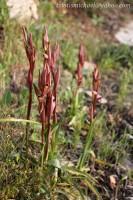
Serapias vomeracea
Date taken: March 26, 2014 |
|
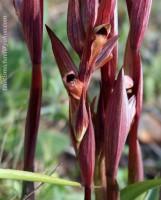
Serapias vomeracea
Date taken: March 26, 2014 |
|
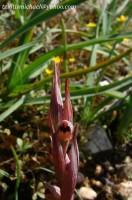
Serapias vomeracea
Date taken: April 06, 2008 |
|
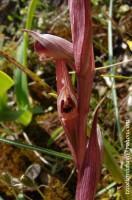
Serapias vomeracea
Date taken: April 06, 2008 |
|
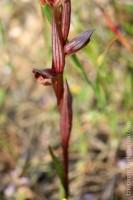
Serapias vomeracea
Date taken: April 14th, 2015 |
|
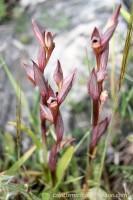
Serapias vomeracea
Date taken: April 14th, 2015 |
|
Select Page of the Album:
|
|



